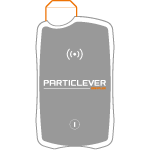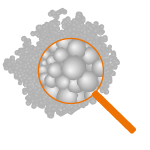Comparison with nanoparticle-related exposure limits
Although no countries have currently implemented regulatory limit values for nanoparticles, there are several recommendations at the European level, in the United States and in Japan.
Here PARTICLEVER only gives a summary presentation of them. The reader is invited to refer to the original documents for all details.
Danger classes for manufactured nanomaterials have been assigned in the international standard ISO/TS 12901-2 “Nanotechnologies - Occupational risk management applied to engineered nanomaterials - Part 2: Use of the control banding approach” It uses a five-band classification (from A no danger to E maximum danger) and classifies non-soluble nanomaterials based on the classification of their analogous substance (the non-nano form). Control bands A through D each have a range of exposure limits to adhere to. Non-soluble nanomaterials are all classified in bands C through E, as the exposure limit values do not exceed 0.1 mg/m3.
In France, The INRS (National Institute for research and safety) proposed in March 2016 using an exposure limit value of 0.3 mg/m3 for ultrafine TiO2.
It also indicates that formulating professional exposure limit values in terms of particle count cannot be supported by a sufficient scientific foundation.
Hygiène et Santé au Travail, n°242 – March 2016 – pp 46 to 51
| Great Britain | Germany | |
|---|---|---|
| Fibrous nanomaterials (NTC, etc.) | 0.01 fibers/cm3 | 0.01 fibers/cm3 |
| Insoluble nanomaterials with specific toxicity |
0.1 × non nano OEL | 0.1 mg/m3 |
| Insoluble nanomaterials ithout any specific toxicity |
0.066 × non nano OEL or 20,000 part./cm3 |
0.5 mg/m3 |
| Soluble nanomaterials | 0.5 × non nano OEL | non nano OEL |
BSI PAS 6699-2:2007 (Guide to handling and disposal of manufactured nanomaterials, BSI, UK)
Announcement on Hazardous Substances 527 ―Manufactured Nanomaterials (May 2013) - The Federal Ministry of Labour and Social, Germany
Recently the BAUA (Federal Institute for Occupational Safety and Health) lowered the value for biopersistent nanomaterials without any specific toxicity to 0.075 mg/m3 for an agglomerate density of 1. This value must be altered in proportion to density.
It confirms nonetheless that the value of 0.5 mg/m3 is still plausible in the case where nano and non-nano substances are mixed.
Assessment criterion (reference value) for nanoscaled GBP, Edition: June 2015
At the European Commission level, the following nanoparticle exposure threshold values and values with no effects are given:
| Substance | REL* (μg/m3) | DNEL* (μg/m3) | Reference | |
|---|---|---|---|---|
| MWCNT | Long term exposure | 50 | Pauluhn, 2009 | |
| CNT and CNF | 8 h TWA | 1 | NIOSH 2013 | |
| Fullerenes | Chronic inhalation | 270 | Stone et al 2009 | |
| Ag (18-19nm) | DNEL | 98 | Stone et al 2009 | |
| TiO2 (10 -100nm) | 10h/day, 40h/week | 300 | NIOSH 2011 |
Table from “Guidance on the protection of the health and safety of workers from the potential risks related to nanomaterials at work”, European Commission, November 2014
NIOSH = National Institute for Occupational Safety and Health (United States)
*REL = Recommended exposure limit *DNEL = Derived no effect level
In Japan, the NEDO (New Energy and Industrial technology Development Organization) has issued a recommendation for TiO2 at the nanometric scale of 0.6 mg/m3.
Risk assessment of Manufactured Nanomaterials – Titanium dioxide (TiO2) – Final report issued on July 22, 2011
Contents of the nanoparticles dossier
- DOSSIER: Nanoparticles
- Nano definitions
- Size of collected particles
- Assessment of nanomaterial-related risks
- Comparison with nanoparticle-related exposure limits
- Evaluating exposure in steps
- Separating out background noise
- Nanoparticle stagnation in air
Contact us
+33 (0)149667576



